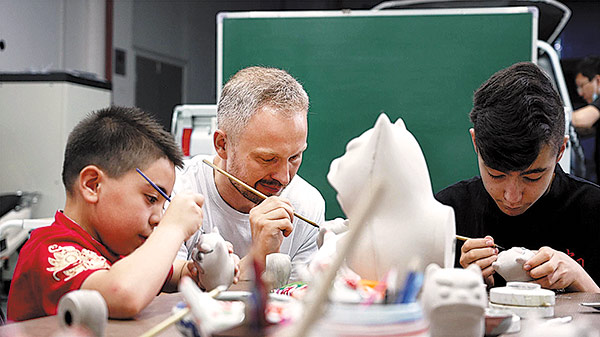

Visitors from France, Italy and Poland recently experienced the charm of traditional Chinese culture and art creation in the production process of the handicraft porcelain tigers at the Weifang Hi-Tech Industrial Development Zone in Shandong province.
One of China's intangible cultural heritage, Weifang's porcelain tigers are inherited from the city's traditional mud tigers and added innovation into modern aesthetics. In terms of materials, porcelain tigers replace the original Honggangzi soil with Gaobai mud, making its appearance smoother and more exquisite, which is not easy to deform.
To ensure the quality, high-temperature glaze coloring is used to color the porcelain tigers, which not only makes the porcelain smooth and delicate in color, but also prevents it from shrinking glaze when heated.
In terms of appearance, a variety of "tiger" shapes of different colors and forms are applied, and traditional old cotton cloth color elements are added to give tiger new life characteristics. It does not lose tradition, but still looks both novel and interesting.
Jakub from Poland is a teacher at a university in Weifang and has a strong interest in traditional Chinese culture.
"I used to bring a few of these little tigers to my family, but I didn't know much about the process of how they're made," he said. "Now, I can explain it to them."
Each porcelain tiger needs to be made through a process that includes swinging, painting, glazing and firing. The entire production cycle lasts for five or six days.
Porcelain tigers are also designed with modern functions such as small night lights, aromatherapy, speakers, vehicle decorations and humidifiers. Rene Chen and Claude Chen are brothers from France who are passionate about Chinese culture and recently came to visit China.
"The visit to Weifang is very meaningful as a window to understanding traditional Chinese culture," Rene Chen said.
Kang Jian, an inheritor of Porcelain tigers, said: "For so many years to make porcelains, I feel that I have the responsibility to bring the cultural memories of our era to the contemporary young people in an innovative form."
"Behind the innovation is to take its essence, protecting and inheriting traditional culture. And catering to the development of the times is also important to furthering traditional culture," Kang said.